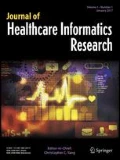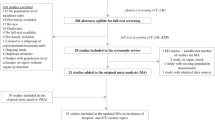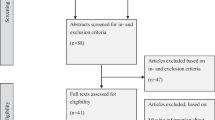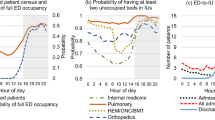Abstract
Prediction of inpatient mortality is not an easy problem since multiple comorbidities and other factors in synergy have a variable effect on inpatient death risk. This research combined Healthcare Cost and Utilization Project (HCUP) tools (clinical classification software, CCS; Chronic Condition Indicator, CCI) to recommend a critical set of CCS diagnosis and procedure predictors for mortality. The study motivation is to provide the research community an up-to-date critical set of inhospital mortality predictors. The study follows a cross-sectional design. An inpatient CMS claims file (N = 418,529) was combined with the HCUP grouper to transform the ICD-10-CM and CPT codes to CCS categories and to enhance the data with the acuity and the diagnosis presence/non-presence on admission. Five logistic regressions were conducted to progressively enhance the feature set with the aforementioned dimensions. The Sensitivitydeath and positive predictive value (PPVdeath) were estimated for each consecutive step to examine the attributable predictive power of each dimension. When all information were inserted, the PPVdeath was 65.5%, a 10% increase over a single representation of secondary diagnoses. A critical collection of significant CCS diagnoses and procedures were extracted as predictors of inpatient mortality. The chronicity and POA status of a diagnosis improve the prediction of inpatient mortality. Furthermore, the combined use of these dimensions provides better predictions against the Elixhauser Comorbidity Index. The combined use of HCUP tools provides a reasonable estimate of inpatient mortality. This is the first study that uses the updated HCUP groupers for ICD-10-CM to provide insights about drivers of inpatient mortality.


Similar content being viewed by others
References
Taylor A, Pare J, Venkatesh A et al (2016) Prediction of hospital mortality in emergency department patients with sepsis: a local big data-driven, machine learning approach. Acad Emerg Med 23(3):269–278
Khojandi A, Tansakul V, Li X, Koszalinski RS, Paiva W (2018) Prediction of sepsis and hospital mortality using electronic health records. Methods Inf Med 57(4):185–193
Awad A, Bader-El-Den M, McNicholas J et al (2017) Early hospital mortality prediction of intensive care unit patients using an ensemble learning approach. Int J Med Inform 108:185–195
Awad A, Bader-El-Den M, James McNicholas J (2017) Patient length of stay and mortality prediction: a survey. Health Serv Manag Res 30(2):105–120
Partington A, Chew DP, Ben-Tovim D, Horsfall M, Hakendorf P, Karnon J (2017) Screening for important unwarranted variation in clinical practice: a triple-test of processes of care, costs, and patient outcomes. Aust Health Rev 41(1):104–110
Krautz C, Nimptsch U, Weber G et al (2018) Effect of hospital volume on hospital morbidity and mortality following pancreatic surgery in Germany. Ann Surg 267(3):411–417
Amato L, Fusco D, Acampora A et al (2017) Volume and health outcomes: evidence from systematic reviews and from evaluation of Italian hospital data. Epidemiol Prev 41(5–6 (Suppl 2)):1–128
Elsebaey MA, Elashry H, Elbedewy TA, Elhadidy AA, Esheba NE, Ezat S, Negm MS, Abo-Amer YEE, Abgeegy ME, Elsergany HF, Mansour L, Abd-Elsalam S (2018) Predictors of hospital mortality in a cohort of elderly Egyptian patients with acute upper gastrointestinal bleeding. Medicine (Baltimore) 97(16):e0403
Özgür Doğan N, Akıncı E, Gümüş H et al (2016) Predictors of inhospital mortality in geriatric patients presenting to the emergency department with ischemic stroke. Clin Appl Thromb Hemost 22(3):280–284
Morsy KH, Ghaliony MA, Mohammed HS (2014) Outcomes and predictors of hospital mortality among cirrhotic patients with non-variceal upper gastrointestinal bleeding in upper Egypt. Turk J Gastroenterol 25(6):707–713
Burke R, Jones C, Hosokawa P et al (2018) Influence of nonindex hospital readmission on length of stay and mortality. Med Care 56(1):85–90
US Tools & Software Page. HCUP. https://www.hcup-us.ahrq.gov/toolssoftware/ccs/ccs.jsp Accessed 7 Feb 2020
Chronic Condition Indicator (CCI) for ICD-10-CM (Beta Version). https://www.hcup-us.ahrq.gov/toolssoftware/chronic_icd10/chronic_icd10.jsp. Accessed 7 Feb 2020
Fowler B, Rajendiran M, Schroeder T et al (2017) Predicting patient revisits at the University of Virginia health system emergency department. In Systems and Information Engineering Design, SIEDS, IEEE Symposium
Tabak Y, Sun X, Nunez C et al (2014) Using electronic health record data to develop hospital mortality predictive model: acute laboratory risk of mortality score (alarms). J Am Med Inform Assoc 21(3):455–463
Concept: Elixhauser Comorbidity Index. http://mchpappserv.cpe.umanitoba.ca/viewConcept.php?printer=Y&conceptID=1436#a_references. Accessed 7 Feb 2020
Sessler DI, Sigl JC, Manberg PJ, Kelley SD, Schubert A, Chamoun NG (2010) Broadly applicable risk stratification system for predicting duration of hospitalization and mortality. Anesthesiology 113:1026–1037
Elixhauser A, Steiner C, Harris DR et al (1998) Comorbidity measures for use with administrative data. Med Care 1:8–27
Fogerty MD, Abumrad NN, Nanney L, Arbogast PG, Poulose B, Barbul A (2008) Risk factors for pressure ulcers in acute care hospitals. Wound Repair Regen 16(1):11–18
Ash AS, Posner MA, Speckman J, Franco S, Yacht AC, Bramwell L (2003) Using claims data to examine mortality trends following hospitalization for heart attack in Medicare. Health Serv Res 38(5):1253–1262(10)
D'Hoore W, Bouckaert A, Tilquin C (1996) Practical considerations on the use of the Charlson comorbidity index with administrative databases. J Clin Epidemiol 49(12):1429–1433
Charlson ME, Charlson RE, Peterson JC, Marinopoulos SS, Briggs WM, Hollenberg JP (2008) The Charlson comorbidity index is adapted to predict costs of chronic disease in primary care patients. J Clin Epidemiol 61(12):1234–1240
Ghali WA, Hall RE, Rosen AK, Ash AS, Moskowitz MA (1996) Searching for an improved clinical comorbidity index for use with ICD-9-CM administrative data. J Clin Epidemiol 49(3):273–278
De Groot V, Beckerman H, Lankhorst GJ, Bouter LM (2003) How to measure comorbidity: a critical review of available methods. J Clin Epidemiol 56(3):221–229
Stewart D, Wang L (2011) Hospital costs, length of stay and readmission rates for C. difficile colitis: comparing outcomes between CDC as the principal and secondary admission diagnosis. Gastroenterology 140(5):S-1013
Di Capua J, Somani S, Kim J et al (2017) Hospital-acquired conditions in adult spinal deformity surgery: predictors for hospital-acquired conditions and other 30-day postoperative outcomes. SPINE. 42(8):595–602
Glance L, Stone P, Mukamel D et al (2011) Increases in mortality, length of stay, and cost associated with hospital-acquired infections in trauma patients. Arch Surg 146(7):794–801
Research brief: Hospital-acquired conditions lead to avoidable cost and excess deaths. Watson Health Perspectives 2019. https://www.ibm.com/blogs/watson-health/research-brief-hospital-acquired-conditions-lead-to-avoidable-cost-and-excess-deaths/. Accessed 7 Fe 2020
Lagu T, Pekow PS, Stefan MS, Shieh MS, Pack QR, Kashef MA, Atreya AR, Valania G, Slawsky MT, Lindenauer PK (2018) Derivation and validation of an in-hospital mortality prediction model suitable for profiling hospital performance in heart failure. J Am Heart Assoc 7(4):e005256
Gagne JJ, Glynn RJ, Avorn J, Levin R, Schneeweiss S (2011) A combined comorbidity score predicted mortality in elderly patients better than existing scores. J Clin Epidemiol 64(7):749–759
Chi M-j, Lee C-y, Wu S-c (2011) The prevalence of chronic conditions and medical expenditures of the elderly by chronic condition indicator (CCI). Arch Gerontol Geriatr 52(3):284–289
Lekshminarayanan A, Bhatt P, Gandhi V et al (2018) National trends in hospitalization for fever and neutropenia in children with cancer, 2007–2014. J Pediatr 202:231–237.e3
Black J, Reaven F, Mcgaughey O et al (2017) Medical comorbidity in narcolepsy: findings from the Burden of Narcolepsy Disease (BOND) study. Sleep Med 33:13–18
Sakhnini A, Saliba W, Schwartz N et al (2017) The derivation and validation of a simple model for predicting in-hospital mortality of acutely admitted patients to internal medicine wards. Medicine 96(25)
Brown LM, Calfee CS, Matthay MA, Brower RG, Thompson BT, Checkley W, National Institutes of Health Acute Respiratory Distress Syndrome Network Investigators (2011) A simple classification model for hospital mortality in patients with acute lung injury managed with lung protective ventilation. Crit Care Med 39(12):2645–2651
Hallstrom AP, Cobb LA, Swain M et al (1985) Predictors of hospital mortality after out-of-hospital cardiopulmonary resuscitation. Crit Care Med 13(11):927–929
Claxton AR, Wong DT, Chung F, Fehlings MG (1998) Predictors of hospital mortality and mechanical ventilation in patients with cervical spinal cord injury. Can J Anaesth 45(2):144–149
Friedrich JO, Wilson G, Chant C (2006) Long-term outcomes and clinical predictors of hospital mortality in very long stay intensive care unit patients: a cohort study. Crit Care 10(2):R59
Zhang Z, Xu X, Ni H, Deng H (2014) Platelet indices are novel predictors of hospital mortality in intensive care unit patients. J Crit Care 29(5):885–8e1
Bhandari M, Koo H, Saunders L, Shaughnessy SG, Dunlop RB, Schemitsch EH (1999) Predictors of hospital mortality following operative management of hip fractures. Int J Surg Investig 1(4):319–326
Author information
Authors and Affiliations
Corresponding author
Ethics declarations
Conflict of Interest
The authors have no competing interests.
Additional information
Publisher’s Note
Springer Nature remains neutral with regard to jurisdictional claims in published maps and institutional affiliations.
Rights and permissions
About this article
Cite this article
Zikos, D., Shrestha, A. & Fegaras, L. A Cross-Sectional Study to Predict Mortality for Medicare Patients Based on the Combined Use of HCUP Tools. J Healthc Inform Res 5, 300–318 (2021). https://doi.org/10.1007/s41666-021-00091-x
Received:
Revised:
Accepted:
Published:
Issue Date:
DOI: https://doi.org/10.1007/s41666-021-00091-x




